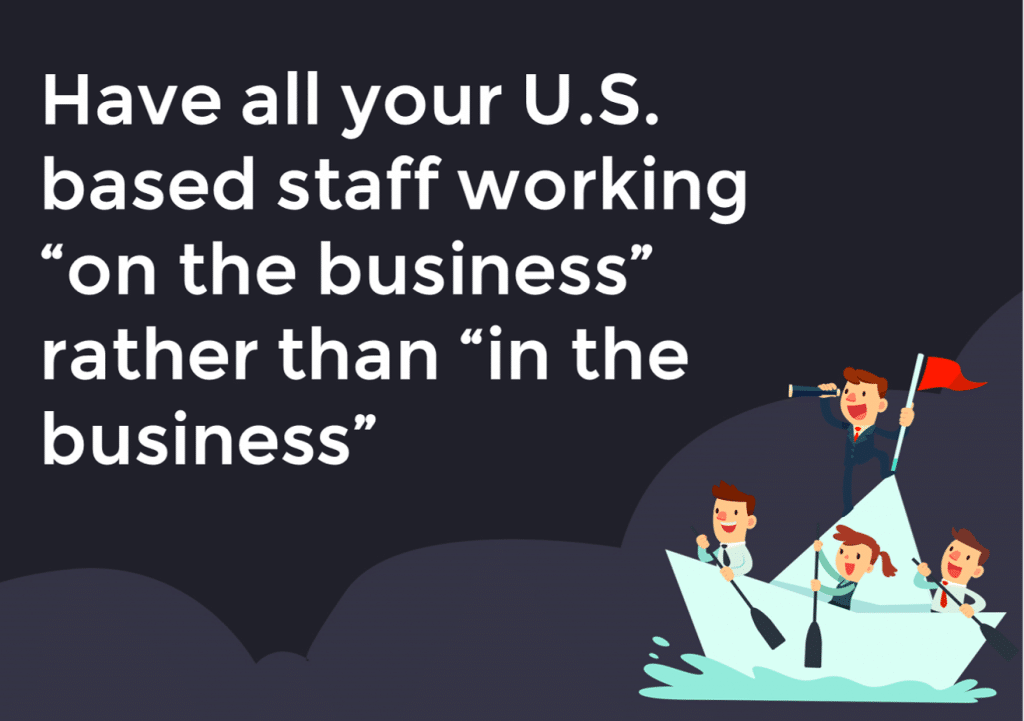Are There Any Even Smarter Ways to Leverage Virtual Assistants? Staffing Agency Smarts

Hiring virtual assistants is a sound strategy for most small businesses. There are even smarter ways to do it.
There is no doubt that hiring virtual assistants is a sound strategy for most small businesses. Significant gains can be made in both costs savings and productivity.
Having said that, our staffing agency is often asked the following question, “are there any even smarter ways to leverage virtual assistants?”
A more advanced method of leveraging Filipino offshore virtual workers is to hire U.S. staff as managers or team builders, rather than as individual contributors. Hiring U.S. staff in this way will add a turbo boost to your business.
Advanced – Smarter Strategies for Growing a Small Business
Here’s what most owners and or hiring managers do when they are hiring. They will define a job, hire locally, train and manage their worker, provide pay raises and promotions over time.
Eventually that worker, who has demonstrated competence at their job, will get promoted to something else. At that point, the person who did the hiring now has to start again to hire and fill the original position.
Even in the best of cases, the service provided by that worker will wobble or become erratic through an extended hire, replace, and training period.
In the U.S. it is often deemed necessary to promote people out of the job they are good at, in order to keep them. After all, who wants to stay doing the same job for the same pay forever?
In the majority of cases, you cannot keep people in the same job at the same pay level indefinitely. Also, you cannot keep giving pay rises to someone who does the same job with more or less the same level of efficiency. Staffing economics does not work like that.
Typically, when a business grows, a given job function will require additional people to be hired to manage the increased workload. This is a very linear model. When an employee becomes maxed out, a new person must be hired, then when they too become maxed out, another must be hired, and so on. In this case, the business costs increase in a linear fashion proportional to output.
A much smarter and more advanced strategy is when hiring U.S. staff, to hire managers not workers. This shift will fundamentally change the dynamic of the business.
Hire a local person and make it clear from day one that their job is to build a team to do the work, rather than the hire being expected to do the work themselves indefinitely. At first glance, this suggestion may sound crazy but hear me out before you scoff at the practicality of it.
Your New Local U.S. Hire – Start with the End Goal in Mind
- Their job should be to do the work but only to start with. They should get the work done with the explicit goal of becoming “an expert” at how to get it done in the most efficient manner.
- As soon as they reach this “expert” level, as soon as they have the work completely understood, their priority should be to replace themselves with a virtual assistant.
- As the business grows and more work needs to be done, they simply hire more virtual assistants.
Economically this works because you can hire 5 – 6 virtual assistants for the cost of one U.S. employee at the same skill level. The big economic shift is that in the U.S. you had better step up, be creative, solve problems and manage people rather than be content to just be a worker. If you do not, sooner or later you will find yourself in competition with low-cost workers from other countries.
The Difference in The Cost Models is Startling!
- In the first “Traditional Linear” model, monthly costs jump in multiples. Assuming an average monthly salary of $4,000 for each employee, this is what it looks like:
- 1 x Work Output = $4,000,
- 2 x Work Output = $8,000,
- 3 x Work Output = $12,000
- 4 x Work Output = $16,000 and so on
- In the second “VA Manager” model, monthly costs jump in fractions. Assuming an initial monthly salary of $4,000 for one U.S employee, and an average of $1,000 for each virtual assistant, this is what it looks like:
- 1 x Work Output = $4,000
- 2 x Work Output = $5,000
- 3 x Work Output = $6,000
- 4 x Work Output = $7,000 and so on
The cost difference at four times the work output is $7,000 compared to $16,000 in a traditional hiring model. That is a cost-saving of 56%. You’ve just saved $10,000 a month.
Add to this difference the hidden costs of your U.S. employee and the model becomes even more attractive. Whilst this is a very simple model, in our experience running multiple businesses, as well as a staffing agency, the benefits though clear, are understated.
Significant Additional Benefits
- The numbers above are conservative averages that do not take into account the hidden costs of U.S employees. We would estimate that real costs savings are likely to be up to 30% greater for most companies.
- Your original hire, the VA Manager, can focus on improving the processes rather than doing the work. This is analogous to “working on the business, rather than in the business”. In just about all cases where this model is implemented, we see significant additional productivity boosts to the business.
Your original hire, the VA Manager, can focus on improving the processes rather than doing the work. This is analogous to “working on the business, rather than in the business”. In just about all cases where this model is implemented, we see significant additional productivity boosts to the business.
- Your VA Manager has a natural way to grow with the business, taking on more responsibility over time. This is as opposed to getting promoted to a different job in order to progress. This means their expertise is directly and consistently leveraged for their core competency within the company.
- In a lot of cases, when a team is built, productivity can be significantly boosted by breaking the work into separate micro-processes. Rather than having each individual do the full job, each person specializes in a subset of the work. Productivity boosts though this approach can as much as double or triple output.
- Another benefit is that should your U.S. hire leave, everything will not grind to a halt. If they have trained their team well, the team will simply get on with the job, regardless of their manager leaving.
Real-world Example
As part of an initiative to boost sales in a small business generating $16m annually the “VA Manager” model was implemented. The company averaged $960,000 in revenue a month. They were located in Orange County, California, and manufactured luxury products for sale all over the U.S. and Canada.
Sales were mainly obtained through their website and eCommerce store. In this case, therefore, the “VA Manager” approach was taken to drive up the online visibility of the company.
The company hired an expensive experienced digital marketing specialist. She, let’s call her “Kristen”, spent three months figuring out how to improve the incoming lead and eCommerce sales of the business’s website. Kristen was able, by herself in her first three months, to drive an improvement in revenue of about 5%. That equaled $66,667 in additional revenue a month for the company. Pretty good.
At that point, she started working with the Smart VA Staffing Agency with the intent of hiring, building, and training a virtual assistant team. It was not long before she was delegating specific tasks to her new team members. It took just two weeks to get the first four in place.
After a further six months on the job, she had a team of six virtual assistants. At a total monthly cost of $12,000. Her salary was $6,000, her team of six VA’s averaging $1,000 a month.
One year Into the Job, Her Team Boosted Average Monthly Sales by 27% or $320,000
Here’s the math:
- Starting monthly revenue $1,333,333
First three months
- 5% increase, $66,667, total $1,400,000.
- Monthly cost of growth $6,000
- Percentage cost of growth 9.0%
Nine months later
- 32% increase, $426,667, total monthly revenue $1,693,333.
- Monthly cost of growth $12,000, one U.S. person and six virtual assistants
- Percentage cost of growth 2.8%
The important point here is that the company saw this level of growth AND a reduction in the cost of that growth. This worked for the following reasons:
- Initially, they hired locally in the U.S., an experienced expert (albeit expensive) person
- That expert built a team of six additional people
- As they were all offshore virtual assistants, the costs for the team did not increase by a factor of six as it would have had they all been U.S. workers
- Indeed, as the budget only allowed for two U.S. people, the reality is that the growth factor would have been the number that suffered

At that point, she started working with the Smart VA Staffing Agency with the intent of hiring, building, and training a virtual assistant team. It was not long before she was delegating specific tasks to her new team members. It took just two weeks to get the first four in place.
What Did The “Expert” Have Her Team Do Exactly?
For those that like the detail. She hired two article writers, one web developer, one graphic designer, one local lister and social account profile builder, and one social engagement specialist. They shared between them such tasks as manning live-chat services and customer service responses. Later she added a technical admin responsible for adding new products to the eCommerce store.
Imagine what you could do with a team of full-time specialists like that…
Why Do So Many Small Businesses Fail?
Is it because managing a small business is rocket science? I would say not. More likely it is that one of the following disciplines is poorly understood or executed.
To successfully grow a small business the owner, or a member of the owner’s management team, must be reasonably good at all the following.
- Economics
- Sales
- Building Processes
By utilizing the above “VA Manager” technique, you will be driving better economics into your business. The same technique also causes a focus on process building. When you hire with the intent of building a remote team enabled through video training, defining and streamlining the process for them to follow becomes a priority.
Conversely, just hiring locally to fill a job does neither of those things. Yet that is exactly what the average small business owner does. The ones that fail or stagnate anyway. As a business owner, you would be smart to be constantly looking for ways to drive better economics into your business. As a test and a thought experiment, ask yourself this question, “what have I done to significantly improve the economics of my business in the last six months?” If the answer is, “not much”, now is your chance!
Build your team of specialists, grow your business by moving from the outdated “Traditional Linear” to the “VA Manager” hiring model. Don’t delay, get started today!






